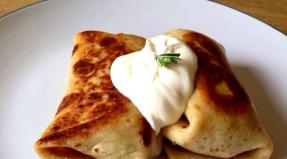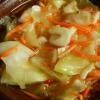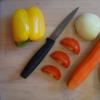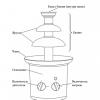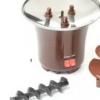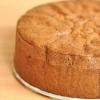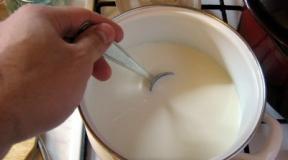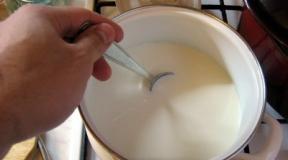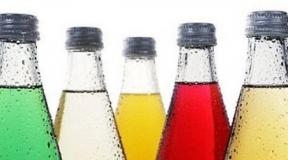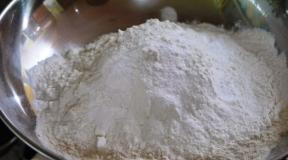Food high in calories. List of high calorie foods
Having taken up weight loss, we begin to monitor the calorie content of the food that we eat every day. In conditions when we are allowed to eat a strictly defined number of calories per day, we have to be very selective in our diet - what is high in calories, we try to replace with what they are less in order to be able to satisfy our hunger (that is, eat more food) without harm to the figure.
High-calorie foods leave our diet until better times.
When counting calories, it is useful to know what the calorie content of a meal depends on. The foods we eat consist of proteins, fats, carbohydrates, they contain vitamins, minerals, various beneficial bacteria, amino acids, etc. Proteins, fats and carbohydrates have energy value. These nutrients, when ingested, begin to be broken down into elements, and when they are broken down, energy is formed that allows us to move, breathe, grow, think and live. Something that has a lot of calories gives a lot of energy. Low-calorie energy foods provide little. High-calorie food, on the one hand, is beneficial if you need a lot of energy for intense physical activity, etc., on the other hand, if you lead a sedentary lifestyle, you don’t need so much energy, because the body has unused nutrients substances are stored in fat.
The calorie content of a meal depends on how many calories are in carbohydrates, proteins and fats contained in it. enters our body. The most "heavy" in terms of calories are fats. Fatty foods are just what are high in calories: 1 g of fat provides approximately 9.1 kcal when broken down. At the same time, it is quite difficult for the body to break down fats, and it prefers to simply store them. Unsaturated fats are the easiest to break down in the body - vegetable oils and fish oil, they are the least harmful to the figure than animal fats or trans fats.
When broken down, proteins give about 4 kcal per 1 g. Their plus is that they are digested for a very long time, the body spends a lot of energy on their processing, which is why everyone who loses weight loves them so much. The disadvantage of proteins is that if there are too many of them in the diet, the digestive and excretory system begins to suffer, since the gastrointestinal tract, kidneys and liver are subjected to a very large load during the processing of proteins.
Carbohydrates are the main energy resource of the body, its fuel. How many calories are in carbohydrates? About the same amount as in proteins, but they break down much easier, the body almost does not have to make an effort to get energy from them, so we can say that the total calorie content of carbohydrates is higher than the calorie content of proteins. Moreover, carbohydrates are different, and your weight is affected not only by how many calories are in carbohydrates, but also by what carbohydrates you eat. Carbohydrates are divided into fast and slow. The calorie content of carbohydrates is the same for both, but the breakdown rate is not. Fast carbohydrates are very quickly absorbed into the bloodstream and give the body a lot of energy at once, but it ends quickly. The body uses almost no energy to process these carbohydrates, and, accordingly, does not spend calories. Slow carbohydrates are more difficult to process, the body has to make an effort to get energy from them, but this energy is enough for a longer time, because it is released and consumed gradually. Therefore, with the same calorie content of carbohydrates of different types, slow carbohydrates are more useful for the figure.
What should be the calorie content of food
During the day, you should get at least 60% of all your calories from carbohydrates. At the same time, remembering the calorie content of carbohydrates and their different types, it must be borne in mind that fast carbohydrates in the daily diet should be 10-15 times less than slow ones. The rest of your calories should be roughly equal in fat and protein. At the same time, something that has a lot of calories, especially sweets, is better to eat in the morning, before 16:00, and in the evening it is better to eat something light, protein or vegetable, something that is quickly digested. Your breakfast should be high-calorie and satisfying, lunch should be hearty millet, and dinner should be as light as possible. Calorie intake during the day should be something like this: 40% before 12:00; 40% until 16:00 and the remaining 20% until 20:00.
What are many calories
The highest calorie foods have a lot of carbohydrates (especially simple ones) or a lot of fat. Please note: Foods containing fiber actually contain fewer calories than indicated on their packaging, since fiber is practically not absorbed in the body.
Here is an approximate list of what is high in calories - these are high-calorie foods, whose consumption you should carefully monitor:
- sugar, sugar-containing products;
- potatoes, Jerusalem artichoke, sweet potato;
- flour, flour products, foods high in starch;
- processed cereals, cereals, semolina, white polished rice;
- muesli;
- candied fruits, dried fruits;
- nuts, seeds;
- fatty meats, poultry, fish, fish roe, lard, mutton fat tail and other animal fats;
- hydrogenated fats (trans fats) - margarine, etc.;
- vegetable oils;
- butter;
- strong meat broths;
- semi-finished meat products, sausage products, smoked, salted and spicy meat and fish snacks, canned food;
- industrial fruit juices;
- ketchup, mayonnaise and other industrial sauces;
- industrial yoghurts, fatty cheeses, fatty fermented milk products, sweet fermented milk products;
- fast food, chips, chocolate bars, milk chocolate, confectionery, soufflé, meringue, marshmallows, etc., pastries, pastry cream, cocoa;
- alcohol.
Should you avoid foods that are high in calories?
We do not need too much energy - as a rule, we do not spend  more than 2000-2500 kcal per day, unless, of course, we do sports or hard physical work. Therefore, in our diet, it makes sense to replace what is high in calories with less high-calorie foods.. For example, instead of fatty meat, eat lean meat, instead of strong broth - light, instead of chocolate - dried fruits, instead of jam - fruit jelly. But this does not mean that we should cross out high-calorie foods from our lives. Fatty fish, caviar, dark chocolate, honey, nuts, cereals and cereals, whole grain bread, and many other high-calorie foods are very useful for our body. Watching the calorie content of food, you must also take into account the usefulness of the products; for your diet, choose only natural high-quality products that do not contain preservatives and other chemicals. Sometimes something with a lot of calories can be more useful than something with less calories, but less natural. For example, high-calorie nuts are much healthier than gummies, although the latter has half the calories. And there are times when we just need to eat something that has a lot of calories in order to restore strength after physical exertion, or to increase our performance, for example, in an exam. Also, high-calorie food is useful for those who do not always have the opportunity to eat - for example, you can’t do without it on hikes.
more than 2000-2500 kcal per day, unless, of course, we do sports or hard physical work. Therefore, in our diet, it makes sense to replace what is high in calories with less high-calorie foods.. For example, instead of fatty meat, eat lean meat, instead of strong broth - light, instead of chocolate - dried fruits, instead of jam - fruit jelly. But this does not mean that we should cross out high-calorie foods from our lives. Fatty fish, caviar, dark chocolate, honey, nuts, cereals and cereals, whole grain bread, and many other high-calorie foods are very useful for our body. Watching the calorie content of food, you must also take into account the usefulness of the products; for your diet, choose only natural high-quality products that do not contain preservatives and other chemicals. Sometimes something with a lot of calories can be more useful than something with less calories, but less natural. For example, high-calorie nuts are much healthier than gummies, although the latter has half the calories. And there are times when we just need to eat something that has a lot of calories in order to restore strength after physical exertion, or to increase our performance, for example, in an exam. Also, high-calorie food is useful for those who do not always have the opportunity to eat - for example, you can’t do without it on hikes.
Below is a list of the most high-calorie foods that you can buy at any store. If you care about your weight, then cut down on these foods. No need to think that high-calorie foods are harmful, they just need to be consumed in moderation. If your goal is weight gain, then some of these foods are worth leaning more often.
No. 1 - Vegetable oil
Vegetable oils are high-calorie foods. There are about 800 - 900 kcal per 100 grams of oil, depending on the variety. There are 9 calories in 1 gram of fat, which means that in 100 grams there are 80-90 grams of vegetable fats. Sunflower oil contains vitamins A, E, D. Unrefined oil retains more vitamins and nutrients than refined oil. The table of the most high-calorie foods is presented below.
Watch Helpful Video #1:
No. 2 - Nuts
Nuts are one of the most high-calorie foods. Peanuts 550 kcal, cashews 630 kcal, hazelnuts 700 kcal, almonds 640 kcal, walnuts 630 kcal, hazelnuts 620 kcal, pistachios 550 kcal, apricot pits 519 kcal. Nuts contain a lot of vegetable fats and these fats are good for our body. Eat a handful of nuts every day, and your hair and skin will be beautiful. Nuts are a delicious product that is loved by children and adults. Nuts can be added to various salads. Nuts are good for the brain, heart and remove bad cholesterol from the body. Nuts are rich in vitamins, minerals and nutrients.
No. 3 - Cheeses
Depending on the variety, cheese contains between 100 and 450 calories. Cheeses contain vitamins B, C, E, PP, A. Cheese contains animal fats, and, as you know, they are not good for people. Buy low-fat cheeses, so you show more concern for your health. If you have an elevated level of cholesterol in the blood, then cheese is not desirable for you or only with a small fat content. Eat cheese in reasonable aisles, and everything will be fine.
No. 4 - Chocolate
Chocolate is different, bitter and sweet. Sweet is less useful, and bitter - on the contrary, is more useful. Dark chocolate has about 500-500 calories, and sweet chocolate has about the same. Chocolate is known to improve mood. Chocolate has a bad effect on the condition of the teeth, because it contains a lot of sugar.
No. 5 - Pork
Pork is one of the fattest meat products. 100 grams contains 400-550 calories depending on the body part. Pork fat is not healthy, because it is animal fat. People who have gastritis - pork can cause significant harm to health. If you often have allergies, then pork should be eaten with caution.
No. 6 - Chips
In 100 grams of chips, about 500-600 calories. Chips are unhealthy food. It is recommended to eat 1-2 times a month, in small quantities. It is not necessary to abuse chips, there is a risk of diseases of the cardiovascular system. Many chips contain salt, flavor enhancers, fast-digesting starch, and unhealthy fats. Many people like to use chips as a snack for beer, but it is better to replace them with natural, healthy and lean meat. Limit the consumption of chips for children.
No. 7 - Chocolate bars
100 grams of chocolate bars contain 450-550 calories, depending on the manufacturer. The most carbohydrates, in the second place are fats, and the least proteins. Chocolate bars are not desirable for people with obesity and for patients with diabetes. If you eat a lot of chocolate bars, you will harm your health. Chocolate bars come with nougat, caramel, nut or fruit filling, bitter or milk chocolate. Chocolate bars are made from cocoa beans, milk, cocoa powder or butter, cream, sugar, sweeteners, caramel nougat.
List of high calorie foods:
- Sausage
- sausages
- Butter
- Margarine
- egg yolks
- Sweets
- Chocolate
- Chocolate bars
- Chips
- Fatty cheeses
- Vegetable oil
- nuts
- Bakery products
- Bakery
- Cakes
Watch helpful video #2:
The enemy must be known by sight. Do you agree? The basic law of weight loss: the number of calories burned should be more than received with food. That is, setting the goal of losing weight, you need to include foods with a reduced calorie content in your diet. It also happens vice versa. If you need to add a few kilograms, food should be as high in calories as possible. Today we will tell you about the most high-calorie foods.
In modern society, an ordinary woman spends 2000 - 2300 kcal per day, and a man - 2500 - 3000 kcal. The daily calorie intake is determined by gender, age of a person, his physical activity and muscle mass. We began to move much less, and eat more and taste better. Our great-grandmothers only 100 years ago spent 4000 - 5000 kcal per day - twice as much! And we often get to the nearest supermarket by car, and someone even to the garbage chute.
Accounting for calories in products
- Calories determine a person's need for energy.
- Rule: in the supermarket, you need to carefully study food labels and choose low-calorie foods (cabbage, cucumbers, tomatoes, zucchini, radishes, cranberries). Then you can easily reduce the calorie content of the daily diet by 200 kcal!
- It must be remembered that the most low-calorie foods contain a lot of water in their composition.
- Keeping a food diary is encouraged, where everything that is eaten per day is recorded to the nearest gram.

The calorie content of any product is determined by the proteins, fats and carbohydrates contained in it. The most high-calorie foods consist of a large amount of carbohydrates and easily digestible fats.
According to the calorie content, it is reasonable to divide products into three groups:
- fat-containing;
- carbohydrate-containing;
- protein.
Fats have twice as many calories as proteins and carbohydrates. They are the most harmful for losing weight. Therefore, it is worth minimizing the use of cakes, pastries with fatty cream, butter and sunflower oil, smoked meats, and fatty pork.
On the 1st place in this group are sweets. These are our favorite chocolates, cookies, cakes, packaged juices, carbonated drinks, coffee with cream. Every fast food and chips are also extremely nutritious. From the sweet, you can sometimes afford citrus fruits, honey and dark chocolate.
Protein products
Protein is the main building material for the human body. Every day a person needs to receive 100-120 g of protein from the outside. To exclude it completely is dangerous for health! From protein products during weight loss, it is recommended to refrain from baked milk, sour cream, and hard cheeses.

It is customary to refer to the most high-calorie foods containing a lot of carbohydrates, bread and potatoes. This is not true! Here is a list of high-calorie foods that correspond to the truth:
- oil: sunflower, butter, lard, margarine;
- meat: fatty pork, lamb, smoked sausages;
- fish: for example, smoked eel and caviar;
- some vegetables (beets, olives) and fruits (bananas, tamarind, grapes, avocados, gooseberries);
- nuts;
- cereals: millet, oatmeal and rice;
- alcohol (especially vodka and liquor);
- ready-made semi-finished products: dumplings, spring rolls, cutlets;
- cakes, pastries, crackers, cookies, chocolates.

- Give preference to meat and fish that are steamed or boiled.
- When eating, be sure to remove the skin from the bird, and choose lean meat. Do not forget about offal: kidneys, heart, ventricles, liver. Canned food in oil is poison for the waist.
- Garnish is preferably vegetable.
- Instead of bread, eat whole grain bread.
- Stew vegetables in water and a small amount of vegetable oil.
- Mayonnaise and sour cream should be replaced with low-fat yogurt, tomato paste, olive oil, soybean oil, corn oil, or flaxseed oil. Exclude spreads and margarine, carbonara and 4 cheese fatty sauces.
- You can't eat a lot of cheese. Hard cheeses are much higher in calories (there are more calories in Cheddar cheese) than processed cheeses.
- A day you can eat no more than 100 g of seeds and 10 nuts.
- Processed foods (pizza, chips, cakes, cookies, chocolate) are only allowed on public holidays.
- Drink green tea with honey and dried fruits. Natural juices are welcome.
- Reduce food portions.
- Abandon restaurant food in favor of home cooking.
Products that do not make you lose weight
Of course, the main thing is to observe the measure while eating. You need to eat both fats and carbohydrates, but little by little. After all, without them, food will become bland and boring!
Diets are always associated with dietary restrictions and taboos. Daily calorie counting is a way to lose weight, in which it is not forbidden to eat your favorite foods, but you need to follow their strict dosage. Thanks to the established calorie intake, you can either lose unwanted kilograms or simply maintain weight at the optimal level.
The essence of the diet
The principle of losing weight on a calorie diet is that during the day the body should receive fewer calories than it spends. Thus, energy will begin to be spent from body fat.
This method is considered the safest, since kilograms will disappear slowly.
“There is nothing tastier than feeling thin”
Kate Moss
Principles
To achieve maximum performance, the following principles must be observed:
- Diet variety
- predominance
- Compliance with the daily norm of fats (80 g) and carbohydrates (100 g)
- Restriction of simple carbohydrates
- Exclusion of sugary drinks and strong alcohol
- Reducing salt intake
- Drinking plenty of water (at least 1500 ml per day)
- Fractional meals 5-6 times a day
Calorie calculation
The opinions of nutritionists on this issue are divided: some are convinced that the calculation for each person is individual, others offer average options.
By formulas
The most common are weight loss options based on the number of calories per day, which depend on the height, weight and age of the person who wants to lose weight. There are several formulas for calculating the optimal calorie content:
Option number 1
(1.8 height, cm) + 655 + (9.6 weight, kg) - (4.7 age, years)
The resulting figure is the amount of energy needed to maintain body systems.
The second stage of calculations will be the determination of the coefficient of physical activity. You can determine it by evaluating your lifestyle:
- Passive lifestyle (sedentary) - 1.2
- Low-intensity activity (physical education 1-2 times a week, walking) - 1.4
- Average level activity (loads more than 3 times a week) - 1.5
- High-level activity (work on the feet, systematic sports) - 1.7
- Excessive activity (heavy daily long-term loads) - 1.9
The number after the first stage is multiplied by the selected coefficient.
The result is weight stability. In order for the weight to begin to decrease, you need to subtract another 400-500 kcal.
Option number 2
30 (height, cm - 105)
The resulting number is to save weight. To reduce it, we take another 300-600 kcal, depending on the activity of the lifestyle.
Average
Weight loss methods from this group do not imply individual calculations, but consist in following a diet of a certain calorie content.
This includes diets for 800, 1000, 1200 calories per day and other options.
What is possible and what is not

A low-calorie diet is not strict about food names. But still there are both more and less suitable food.
Ideally, the diet should include:
- Buckwheat and barley porridge
- Lean meat, poultry and fish
- Cutlets, steamed meatballs
- Egg white
- Mushrooms
- Vegetable soups in light broth
- Rye bread, bran or wholemeal bread
- Vegetables, raw or steamed
- Low calorie fruits (, oranges, etc.)
- Unsweetened tea, coffee, fresh
- Dairy products (yogurt, cheeses)
Unwanted Products
If you wish, you can make your own diet and count calories. But it is important to remember that there are forbidden foods. If they are, then the process of losing weight will be inhibited. Among these:
- Conservation and salinity
- Smoked meats
- Sausages
- Fatty meat, poultry and fish
- Potatoes in any form
- Egg yolk
- nuts
- Pasta
- muffin
- White bread
- Margarine, butter
- Cocoa
- High-calorie fruits and dried fruits
- Sweets (except marshmallows and marmalade)
- Sauces
You can compose a menu by combining products, taking into account their energy value and serving size.
Calorie content of individual products
For the convenience of calculating acceptable food combinations, you can use the calorie table of allowed foods.

Calorie content is indicated for the product in its raw form.
Calorie content of dishes
It is impossible to make a quality menu for every day without knowing the calorie content of already prepared dishes.
Ready meals calorie table:

On a note. For convenience, it is better to print the tables and store them in quick access.
Menu rules
One of the principles of the effectiveness of the diet - eating small portions, but often. The best would be a breakdown of the daily diet for five times. An important point is the correct percentage of calories between meals.
Regardless of whether the calculation is for 1000 calories per day or for any other option, the correct ratio is:
- 25% - breakfast
- 10% - second breakfast
- 35% - lunch
- 10% - afternoon tea
- 20% - dinner
It is advisable to include in each meal in different combinations:
- For breakfast: cereals, fruits, eggs, cottage cheese, tea or coffee
- For a second breakfast: sour-milk products, fruits
- For lunch: broths, soups, meat, bread, vegetables, fish, salads
- For an afternoon snack: sour-milk products, fruits
- For dinner: meat, vegetables, fish, salads, tea
If there is a desire to eat something from the list of not recommended products, then you can not deny yourself this. The main rule is not to go beyond the daily energy value.

A person who decides to lose weight in calories, first of all, must decide on the value of the diet. The safest option is an individual calculation of the daily norm. This is due to the fact that the personal characteristics of a particular person are taken into account.
If you like fixed calorie diets, it is important to consider the following points:
- For stress-free weight loss, it is better to alternate a week with a critical calorie content with a week of weight stabilization.
- It is not recommended to immediately set a low bar (800 calorie diet), this can lead to exhaustion.
- Without harm to health, it is better not to lower the bar below 1200 kcal.
- As an exception, you can vary the daily calorie content based on physical activity. If the day is spent passively, then you can make a fasting day and reduce the value of the diet. If the day is physically difficult, then it is appropriate to increase the calorie content to 1400 or even 2000 kcal.
- It is not advisable to sit on a low-calorie diet for a long time (more than a month).
- The exit should be smooth, gradually increasing the daily calorie content by 300-500 kcal.
- Ideally, the menu for the week should include a food variety to get all the vitamins and minerals.
The most correct decision on the choice of both the diet itself and the calculation of the optimal daily calorie content is consultations with specialists. A gastroenterologist will indicate if there are any contraindications, and a nutritionist will competently write out a nutrition scenario.
Contraindications
Such a system of nutrition is contraindicated for children. There are no absolute contraindications for adults. But in the presence of chronic diseases, especially those associated with digestion, the menu should be drawn up taking into account the advice of a doctor.
A calorie diet is an effective way to fight extra pounds. Its great advantage is the ability to compose products and make a menu yourself. Thanks to calorie tables and kitchen scales, the desire to lose weight is sure to succeed.
Calorie is a unit of energy consumption and energy consumption by the body. A calorie is a certain unit of fuel for the body, which is necessary for normal life, heat production, food processing and other activities. Today we will touch on the topic of why it is so important and how to correctly calculate calories when losing weight.
The main thing in the article
Why is it important to count calories for weight loss?
In order for the weight to start to go away, you need to create a small one. It is a small deficit, because with a large weight loss, health problems can arise, in particular with the heart. The skin will sag, as collagen does not have time to develop and tighten the dermis.
There is another formula that takes into account physical activity:
How to count calories according to the table of ready meals?
- Mono-diets are most dangerous because their list of products is limited, and therefore the chance to break loose increases. More effective nutrition is balanced, when healthy and wholesome foods predominate in the diet, less empty ones are used that do not carry any benefit, but momentarily satisfy the feeling of hunger: cake, ice cream, cakes, buns, sweets and other sweet ingredients.
- It is very important to compose your diet so that its calorie content corresponds to what you calculated for yourself. To do this is very simple, you need to look at the table and find your product.
- One more rule about the distribution of fuel by time of day should be taken into account. In the morning you should eat at least 1/4 of the total amount of calculated calories, at lunch - 1/3, and dinner should not be heavy, its calorie content is approximately equal to 15% of the total calculated amount.
- If only products are presented in the table, then they need to be added to each other, and then calculate the total amount of calories per dish. It should be noted that the table shows values per 100 g of the product. Therefore, if you have less, then you need to take this into account and calculate according to the weight of your product.
Calorie table of ready meals per 100 grams
Below we invite you to take a look at the tables that calculate the calories, proteins, fats and carbohydrates of different dishes per 100 grams of product. It is important to consider that if you add dressings to a salad or oil, then the calorie content will increase. The same applies to cereals and side dishes - 10 grams of butter doubles the calorie content.
First course calorie table



As can be seen from the table, the lowest calorie content falls on the first courses, consisting of dietary meat and vegetables. Calorie content may increase depending on the composition of the dressing and in general its availability.
Reception of first courses usually takes place at lunchtime. It is during this period of time that you need to get enough of a large amount of proteins, carbohydrates and fats.
porridge calorie table


Porridge in the classic version is consumed in the morning, often for breakfast. Breakfast should consist of a large amount of slow carbohydrates so that your body is energized throughout the day. Also, do not forget about proteins and fats.
Note that the calorie calculation is based on the addition of butter, sugar, and other sweeteners.
Side dish calorie table


The side dish is usually added to meat or fish as complex carbohydrates so that the body has enough energy for the rest of the day.
Please note that added sauces and dressings will increase the total number of calories.
Calorie table of ready-made meat dishes
Based on the presented table, it can be seen that fried foods contain not only a lot of fat, but also a high total amount of calories per 100 grams of food. The lighter the food is cooked, the fewer calories it contains and the more beneficial it is for the body.
Calorie table of poultry dishes
Poultry, in comparison with other types of meat, is the least high-calorie, and some of its varieties are dietary. Based on the table, it can be seen that turkey meat contains many times less calories than pork or chicken meat.
Calorie table of fish dishes


Fish is not only a source of phosphorus, but also the main competitor of meat in terms of protein content. And the minimum calorie content makes dishes more in demand for women who want to acquire a slender figure.
salad calorie table

|
Salad name |
Proteins, gr | Fat, gr | Carbohydrates, gr | Calorie content kcal per 100 gr |
| From tomatoes, cucumbers and peppers | 1 | 0,8 | 4,9 | 22,3 |
|
From tomatoes and cucumbers with sour cream |
1,2 | 4,6 | 3,1 | 58 |
|
From tomatoes and cucumbers with vegetable oil |
0,8 | 7,6 | 4,8 | 89,6 |
|
From tomatoes and cucumbers with mayonnaise |
0,8 | 15,4 | 4,9 | 144,5 |
| Radishes with sour cream | 1,9 | 5 | 6,6 | 70 |
| Tomatoes with garlic | 3,8 | 1,8 | 10,2 | 70,8 |
| From fresh cabbage with apples | 1,4 | 0,1 | 6,2 | 33,2 |
| Sauerkraut | 1,7 | 0,1 | 5,4 | 27,4 |
| From sauerkraut and beets | 1,8 | 0,1 | 8,2 | 40,6 |
| Vinaigrette vegetable | 1,6 | 4,8 | 6,7 | 76,5 |
| Vinaigrette with herring | 4,6 | 6,8 | 10,4 | 119,6 |
| Beetroot with prunes, nuts and garlic | 7,6 | 15,2 | 30,9 | 281 |
| With crab sticks and corn | 4,9 | 2,7 | 9,7 | 102 |
| Greek | 4,1 | 17,4 | 4,2 | 188,4 |
| Olivier with sausage | 5,5 | 16,5 | 7,8 | 198 |
| Herring under a fur coat | 8,2 | 17,9 | 4,1 | 208 |
| Tenderness | 5,9 | 8,8 | 30,2 | 213,5 |
| Kremlin | 5,9 | 21,8 | 8,4 | 251 |
| Mimosa | 6,6 | 27,8 | 4,6 | 292 |
| Caesar | 14,9 | 16,8 | 25,9 | 301 |
| Capital (meat) | 15,6 | 25,8 | 4,6 | 324 |
Vegetables are necessary for the body to process other food. They are an indispensable source of fiber, which is involved in the processes of digestion. And the fewer components in the salad, the more dietary its composition.
Second course calorie table


Calorie table for sauces and dressings

| Sauce name | Proteins, gr | Fat, gr | Carbohydrates, gr | Calorie content, kcal per 100 gr |
| Adjika | 1 | 3,7 | 5,8 | 59 |
| anchovy oil | 17 | 18 | 0,3 | 235 |
| orange sauce | 0,6 | 4,6 | 3 | 55,3 |
| Wasabi | 0 | 9 | 40 | 241 |
| Dutch | 2,4 | 10 | 4 | 114,5 |
| Table mustard | 10 | 5,3 | 3,5 | 139 |
| Mushroom | 1 | 6 | 3 | 69 |
| mustard dressing | 1,2 | 31,3 | 7 | 312 |
| salad dressing | 0 | 47,5 | 5,2 | 447 |
| Marinade vegetable without tomato | 1,2 | 7,8 | 12 | 120 |
| Vegetable marinade with tomato | 3,2 | 8,7 | 13,7 | 143 |
| mustard oil | 1 | 79 | 2 | 722 |
| Oil green | 1 | 61 | 3 | 558 |
| Oil with sprats and sardines | 3 | 57 | 3 | 539 |
| Lactic | 3 | 11,5 | 7,5 | 143 |
| White for fish | 15 | 7 | 5,5 | 149 |
| White with egg | 13 | 18,5 | 5 | 236 |
| Mushroom sauce with tomato | 2,8 | 10 | 9 | 134 |
| From butter and hard boiled egg | 5 | 39 | 1,5 | 376 |
| from celery | 2,8 | 21,6 | 10,3 | 244 |
| From horseradish | 2 | 10 | 8,5 | 132 |
| From champignons with cream | 4 | 14,7 | 4 | 163 |
| Cranberry | 0 | 0 | 12,6 | 51 |
| Red sweet and sour | 14 | 5,6 | 35,5 | 240 |
| Mayonnaise | 2 | 72 | 2,6 | 665,5 |
| sour cream | 2,8 | 32 | 6,5 | 326 |
| horseradish sauce | 0,9 | 4,6 | 5 | 64 |
| cheesy | 6 | 11 | 5,5 | 141,5 |
| Egg-butter | 3 | 34 | 0,6 | 321 |
Calorie desserts in the table

| Name | Calorie content, kcal per 100 gr | Proteins, gr | Fat, gr | Carbohydrates, gr |
| Jam | 286 | 0,4 | 0,2 | 74,5 |
| waffles | 425 | 8,2 | 19,8 | 53,1 |
| Hematogen | 252 | 6,2 | 2,8 | 75,5 |
| Dragee fruit | 388 | 3,7 | 10,3 | 73,4 |
| Zephyr | 295 | 0,7 | 0 | 77,3 |
| Iris | 384 | 3,1 | 7,7 | 81,2 |
| Caramel | 291 | 0 | 0,2 | 77,3 |
| Chocolate candies | 576 | 3,9 | 39,7 | 54,6 |
| Marmalade | 289 | 0 | 0,2 | 77,1 |
| Honey | 312 | 0,6 | 0 | 80,5 |
| ice cream ice cream | 223 | 3,6 | 15,1 | 20,5 |
| Creamy ice cream | 182 | 3,6 | 10 | 19,5 |
| popsicle ice cream | 278 | 3,6 | 20 | 19,5 |
| Paste | 301 | 0,6 | 0 | 80,1 |
| oatmeal cookies | 430 | 6,5 | 14,1 | 71,1 |
| Butter cookies | 437 | 10,5 | 5,2 | 76 |
| puff pastry | 543 | 5,7 | 38,3 | 46,8 |
| Biscuit cake | 388 | 4,9 | 9,1 | 84,1 |
| Gingerbread | 333 | 4,4 | 2,9 | 77,1 |
| Sugar | 377 | 0,2 | 0 | 99,6 |
| Sunflower halva | 519 | 11,4 | 29,3 | 54,6 |
| Dark chocolate | 546 | 5,2 | 35,6 | 52,4 |
| milk chocolate | 552 | 6,7 | 35,6 | 52,4 |
As can be seen from the table, sweets and all kinds of desserts have a high calorie content, as well as a lot of carbohydrates. But these carbohydrates are simple, they are quickly absorbed into the blood and processed by the body. Consequently, you quickly become satiated, but after a while you become hungry. Such dishes should be reduced, firstly, because they do not bring any benefit to the body. And secondly, you can’t get enough of them, there will always be few of them.
Calorie table of flour and bakery products
Bakery products have an average calorie content. But keep in mind that some products are made from processed wheat varieties, while others are made from durum cereals. If you want to switch to a proper and balanced diet, then it is better to give preference to products made from rye, buckwheat, oatmeal.
Calorie drinks in the table

| Name | Calorie content, kcal per 100 gr | Proteins, gr | Fat, gr | Carbohydrates, gr |
| apricot juice | 39 | 0,9 | 0,2 | 9,2 |
| Pineapple juice | 48 | 0,2 | 0,2 | 11,4 |
| Orange juice | 36 | 0,9 | 0,1 | 8,4 |
| Grape juice | 56 | 0,3 | 0 | 14,5 |
| Cherry juice | 49 | 0,5 | 0 | 10,6 |
| Pomegranate juice | 58 | 0,2 | 0 | 14 |
| cocoa with milk | 377 | 24 | 17 | 33,1 |
| Bread kvass | 26 | 0,2 | 0 | 5 |
| Cola | 40 | 0 | 0 | 10 |
| Coffee with milk | 56 | 0,8 | 1 | 11 |
| Lemonade | 24 | 0 | 0 | 6,1 |
| Lemon juice | 18 | 1 | 0,1 | 3,2 |
| carrot juice | 31 | 1 | 0,1 | 6,5 |
| Peach juice | 37 | 0,8 | 0,1 | 9,1 |
| Non-alcoholic beer | 22 | 0 | 0 | 4,1 |
| Green tea | 0 | 0 | 0 | 0 |
| Black tea without sugar | 0 | 0 | 0 | 0 |
| Black tea with lemon and sugar 2 tsp. | 41 | 0,8 | 0,7 | 8,3 |
| Black tea with condensed milk 2 tsp. | 112 | 2,4 | 2,4 | 19,3 |
| Energy drink | 47 | 0 | 0 | 11,4 |
| Apple juice | 42 | 0,5 | 0,4 | 9,7 |
As can be seen from the table, during the diet, and indeed, it is better to drink tea or juice. The additional sweet ingredients bring not only a pleasant taste, but also a significant weight to calories.
Complete table of caloric content of ready meals free download
Presented here complete table of calorie content of ready meals, you can download it and use it when calculating your KBJU.
McDonald's calorie content of dishes: table
McDonald's has a handy calorie counting system. This is convenient because choosing certain products, you will always know how much you ate. But as you can see from the table, the food in the institution is very high in calories.
Burger King food calorie table
The fast food restaurant chain has high-calorie food, as its composition mainly includes baked goods with meat. But do not get carried away with fast food, because it will not affect the body in the best way.
Diet and calculation of caloric content of products according to Bormental

- Excess weight often comes from overeating. Stress, depression, or vice versa a good mood - all this is fixed by a good portion of food. And no matter what, the main thing is to seize the pain, and it will become good - this is what most people think. But for the body this is an unbearable burden, it deposits unnecessary components in the form of fat, which, with frequent abuse, becomes very large.
- The Bormental diet is based on reducing calories to 1200 per day. But it should be borne in mind that this calculation was made for people with a sedentary lifestyle. If you lead an active rhythm of life, the calorie content should be increased by about 500 kcal.
- The essence of the diet is that there are no restrictions, as such. You can afford to eat whatever you want. But the main thing is to keep within 1200 kcal. You also need to keep a food diary in which you will enter all the foods consumed per day.
Calorie table of ready meals according to Bormental 


- If you have chosen Bormental nutrition, then you must definitely use the calorie table.
- The specialists of the Bormenthal Center recommend drinking a glass of warm tea after each meal so that the feeling of satiety lasts longer.
- Reduce foods high in fat.
- Increase the amount of building material - protein in the diet.
- Include more vegetables in each meal, and if possible, replace sweets with fruits.
- Meals should be divided into 6-8 meals, three of which are main, and the rest are snacks.
- It is better to get rid of bad habits, without them, not only the body will look better, but also the skin, and hair, and your mood.









